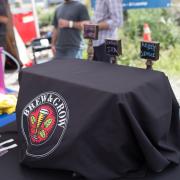Some of you are probably still recovering from Saturday, but Harvest Fest is only two months away! Conrad and I want to get a discussion going about what to do for the next 'school'. We've done hops, then malt. What's next? This is wide open, so please feel free to post your ideas!
Mon, Aug 11, 2014 - 11:11am
#1
Harvest Fest School










Would love to see a Yeast School
A smash beer with different yeast strains could be interesting...
Lance from Omega Yeast will be at the brew house on Thursday!
If he were interested, getting Lance involved with Yeast School would seem like a promising opportunity for both parties
We did hops, malt, the next logical one is yeast. I vote for yeast school.
Also, if I may, I suggest we repeat hops, malt, yeast and the fourth one next year. No one ever remembers something after tasting it once or twice... If members are continually exposed to different hops, malt, yeast, and [fill-in-the-blank-for-a-fourth], they're more likely to learn/remember it and that is the goal (I assume...) of these schools rather than a one time thing with no take-away/lasting educative result.
I think an annual hop school to coincide with an event is a great idea. IPA's are the most popular craft style and there are new hop strains coming out every year. Have a C.H.A.O.S. base recipe (grains bill and clean high AA bittering addition) and use the Flavor/Aroma/Dry hopping to showcase each hop. Could also do regions to further break it down.
Repeating the schools through the years makes definite sense. Recipes and styles could be mixed up from one year to the next, and the order of the schools. Maybe do malt school in May next year, and hop school in the summer with a wheat recipe, etc
Unless you are doing something Harvest-related like Cider School or something for Harvestfest, I think you should move Hop School to that slot. Then we could incorporate wet-hopped and fresh-hopped beers into the mix. I plan on making a wet-hop beer again this year.
Icehouse and I were tossing around the idea of yeast school for our Belgian ale experiments.
Even if it's not official, we'll most likely have at least WY 3522 "Ardenens", WY 3787 "Westmalle", and WY 1762 "Rochefort" present, if not at the harvest fest, then certainly at another club event.
Yeast School it is. Ken, as I am unable to attend Lance's presentation could you be my emissary and see if he'd partner with us. We can totally sell out and call it the Chaos Brewclub Yeast School Presents Omega Yeast Academy or something in exchange for 5-6 pitches. You can give him my contact info if you'd like so we can get the ball
Rolling.
In regards to future schools A hop harvest hop school would be great. I think we could get away with 2 hop schools a year. Malt school, I thought was very successful, people were interested, and people learned, which was our goal, but Hops are hot on the streets and generated far more buzz and interest, I felt anyway. So I would see no harm in doing a spring and fall hop school in the future. There's a lot to explore given the comparative nature of the School Series, a lot of different directions to help keep fresh.
Just something to keep in mind for the fall party. I have a friend out in Yakima who can overnight us a sack of freshly picked wet hops for cheap (the hops will be cheap, the ovenighting may not be). He works out by the farms and he could get us as much as we want. If someone wants to head up a group brew wet hop beer I can coordinate the hops. Maybe brewing can be an event itself or maybe its just a Tuesday Brewsday thing. Let me know and I can get the hops.
Thanks James. When might be a good time to try to get some hops from your friend? Would early September work, around the Open House or BrewsDay for brewing at one of those times?
Also thinking about Yeast School, and something making that concept easier is that since the brews will be the same, the beers could potentially be cranked out in 15-gal batches on the Tower of Power, and that would even make them more consistent
Joe and co., what do you think about the Schools going forward? It would probably be great for everyone to have some idea to what think about for Stout Night, and in to the future, even just roughly speaking -
Fall 2014 (Harvest Fest) - Yeast School
Winter 2015 (Stout Night) - ??
Spring 2015 (Cerveza de Mayo) - Hop School again?
Summer 2015 (BrewBQ) - ??
Fall 2015 (Harvest Fest) - Fall Hop School was proposed?
Stout night could be same stout with different adjuncts (cherry, vanilla bean, oaked or any other addition.)
"Give a man a beer, and he will waste an hour. Teach a man to brew, and he will waste a lifetime!" Bill Owen
I like Pete's idea for Stout Night....
I also like Pete's idea
Another idea for future schools is to include some smaller batches. Maybe just have a gallon of two that has some particularly unusual ingredient added, rather than having to make and be stuck with 5 gallons of it.
This is especially feasible if we are making 15 gal of the standard recipe on the ToP, split that in to 5 or 10 different educational offerings
How about stout night with different wood components. There are a wide varitey of wood spiral and honeycomb options for different wood species. You could do stouts (since its stout nite) with different woods like hickory, French Oak, American Oak, Cedar, Ash, maple, Birch, etc.
Spirals and honeycombs are about 5 weeks for full extraction. If there is interest I could even reach out to blackswan to see if they would donate wood.
Dave, That's a perfect Idea! I love it!!! Would someone volunteer to work with me getting that one setup. the Yeast school I can handle, my son is due to make his appearance in late December, and I can't promise I'll have the time to give stout night school series 100%.
Also, yeast school, what should the base style be, I was thinking maybe an English mild, something with some Marris Otter and a decent hop presence so ;the yeasts ability to highlight hops or malt will allow it to swing either wayWhat strains are we gonna use I suppose will be answered by Lance if he chooses to be involved.
Also, we could call it Chaos School Series: Woodshop
^What strains are we gonna use I suppose will be answered by Lance if he chooses to be involved.
Icehouse and I will volunteer to brew the Ardennes, Rocheforet, and Westmalle strains.
Any more info or ideas for Yeast school for Harvest fest? That event is two months from tomorrow
Talked to Lance on Thursday night after the Yeast Workshop, he thought it was a great idea and that we would learn quite a bit.
His suggestion: Pale Ale with all Two Row and 12 IBUs (O.G. - 1.050)
For Yeasts:
He is currently testing a couple of additional hybrid strains as well that he might have ready for us within the next month as well.
I wouldn't mind doing the British Ale yeast.
Ken,
Can you remind what the "Belgian Saison" strain is?
We were definitely planning on using the more well-known Trappist strains, such as Ardennes (Achel), WY3787 (Westmalle/Westvleteren) and WY 1762 (Rochefort).
I personally have no experience in brewing saisons.
-James
Would it throw off the pitch rate too badly to make some of these as smaller batches, say 3 gal instead of 5? If that's not a problem, we could have some smaller batches for some of the more uncommon strains, say doing 15 gal on the Tower of Power and having 5 x 3gal batches, to increase the variety but limit excessive volume.
That said, I definitely want to sign up for something here, whenever signups are available.
I'd actually prefer to brew with the 1007 over the Belgian Saison strain.
Circling back to the idea of Woodshop as possible school for Stout Night, Joe do you want to go with that idea? If so, we should get a recipe set ASAP so that there is sufficient time to brew and age on wood.
If so, what would you guys think about having a few batches brewed for this as part of Learn to Homebrew Day on November 1? That would be a good day to brew some identical batches, side by side, with the help of some new/potential members, and encourage those folks to come back for the Party. The timeline for those batches then would be November 1 Brew, 6 weeks for fermentation, add wood in early-mid december, age on wood for 5 weeks, serve on Stout night. What do you think?
Jamie has a very good point and we definitely need to start thinking about this recipe and timeline.
The type of wood (I.e. chips vs. cubes) will make a huge difference in the length of time needed to soak.
We may want to reach out to Black Swan cooperage and pitch them our idea. They do a honey comb method that is patent pending and designed for Homebrewer's and nanobreweries.
Hi everyone. I know I talked about this with Joe earlier, but does anyone have a keg I could bottle my yeast lab beer in for the party. It's ready. I'm a little short on bottles and figured it'd be easier to have a keg of it, anyway. I'm brewing tomorrow and, although I don't know how to keg a beer, can help with it then. I'm also willing to clean it and everything associated with it. Thanks!
John
John, I'm typically a consitent advocate for kegging over bottling, but in this case, I would point out that all of the other beers for this feature are bottled. So in this rare case, bottles might actually be the easier way to go
John, I have one you can use if you end up needing it. You'll recognize it too because you replaced all the rings on it the other night...
My blue and white keg is next to the keezer waiting for you...
I'd like to encourage us - as an overall goal for the club but especially something called "school" - to really strive for attendees to take some unforgettable and practical beer knowledge away with them.
What we're doing with the schools is awesome but what will we do to ensure both the beer-lover and beer-brewer can remember and use what they've learned?
The first thing that pops into my mind is a handout explaining yeast (what the hell is it besides some powdered grains or some milky, pungent liquid?), then explain some common terms associated with yeast (e.g., attenuation) and then list the X number of yeasts we used, give some space for people to take notes (and leave some golf pencils at the yeast school station) on how it tastes (and the person pouring at the yeas school station would interact with the guests, explaining to them using beer tasting lingo - e.g., "grainy" - the different tastes for our yeasts and the guest can jot down some tasting notes). Obviously, if we're doing any self-serve stations using the barrel tap system, the yeast station is the one that should not be self-serve; someone should be there to teach.
Including that info about the yeast strains on some kind of printed material to hand out would be great, whether on the standard menu, or making that an additional, standalone item.
Yeast lab beers will be all bottles, or almost all bottes, so they would not be on the self-serve barrel. IMO, doing "School" in the front bar worked well last time and that would be a good place to do again this time
Who did the signage for the grain school?
That was Nancy's fine work. I believe she has the yeast school signage mocked up but the text isn't written yet. Haven't had the time to check on either of those things just yet.
Thanks Joe.
BTW- My Yeast Lab beer turned out great!
Joe and Rich, thanks a lot for your willing ness to let me fill your kegs with beer. Just kidding, honestly, thanks. I will take Jamie's advice and keep this school consistent and bottle my beer. I'm hoping to obtain all the bottles during the family bottle share Saturday and bottle it early next week. I'll also update the spreadsheet as best I can tomorrow. Jeff/Conrad, do you want us to write up something about the yeast ourselves or are you going for a more standardized feel? Thanks!
John if you want to write a blurb about your yeast that would be great, something short, about a paragraph or so should do, thanks!
I tried including in the spreadsheet, but it was too long. Here it is, feel free to edit it as you see fit!
Kolsch yeast has a good attenuation and a low flocculation, providing a clean, crisp finish. Since this yeast can ferment between 55-70 degrees Fahrenheit, it compliments a broad range of styles, from German Ales and Kolschs to light blonde and Alt style beers. The flavors usually imparted from the Kolsch yeast are fruity in character and sometimes carry a lager like profile. The yeast originates in Cologne, Germany and has a storied past and promising future in the hands of creative craft beer makers.
Joe, can I borrow your keg for the next three weeks?